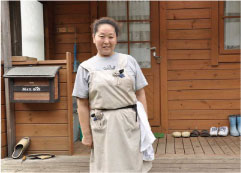 |
|
Atsuko Ogasawara in front of Asako House
|
A major earthquake hit eastern Japan on March 11, 2011. The Fukushima Daiichi NPP was critically damaged and has been emitting large amounts of radionuclides since that time. This earthquake-vulnerable country has nuclear power plants nationwide. A small but increasing number of municipalities are adopting antinuclear policies. Regarding the Ohma NPP project, however, politicians and local municipalities are clear about having no plan to give it up.
The town of Ohma, where the nuclear power plant is under construction, is situated at the northernmost tip of Honshu, the largest Japanese island. There are two large plots of land, about one hectare in total, in the middle of the planned NPP premises. Their former owner was the late Asako Kumagai, who opposed the NPP project and did not agree to sell the land to the Electric Power Development Company (J-Power), the would-be operator of the plant. Because of the disagreement with Ms. Kumagai, the company reviewed the construction plan and moved the reactor core position, which was originally very close to her land, about 200 meters. (The reactor core will still be only 300 meters away from the land, if completed.)
Atsuko Ogasawara is Asako Kumagai's daughter. The mother and daughter together built a log house on one of the plots to show their resistance, but Asako passed away in 2006, before moving into the house. Atsuko Ogasawara has been guarding Asako House ever since.
Ms. Ogasawara, whose home is located in Hakodate, the city facing Ohma across the Tsugaru Strait, visits Asako House several times a week to take care of the house and the vegetables she raises there. The antinuclear action she is most committed to is to request people to write to her at Asako House. She always carries prepaid postcards on which the address of Asako House is printed. The one-kilometer pathway J-Power prepared to allow access to Asako House is unpaved and fenced in on both sides. If someone writes to her, a mail carrier must visit the house, treading the pathway. This whole routine implicitly tells the company, and the neighborhood that cannot see the house from the outside, that Asako House is there, and has not been abandoned.
When I visited Asako House in 2008 for the first time, soon after the Ministry of Economy, Trade and Industry granted a reactor construction license to J-Power, the movement against the Ohma project was rather small. Subsequently, however, geomorphologists have reported that it is highly possible that there are active faults in the areas near the planned NPP site, and in 2010 a group of Hakodate residents filed a lawsuit against the Japanese government and J-Power to suspend construction. Ogasawara joined the group and delivered a speech during the first oral proceedings.
While having a bright and cheerful character, Ogasawara is often filled with emotion and moved to tears when talking in public. I believe that at such a time she strongly wishes she could show the audience to her late mother. When the Ohma NPP project was announced, many local landowners were against it and refused to sell their land at first. However, one after another, they gave up and finally Asako became the only landowner to own major plots of land in the very center of the premises. In the town, where a great majority of the population was in favor of the project, Asako faced a very lonely struggle.
In late May 2011, a rock festival was held on Atsuko's plots, surrounded by cranes and plant facilities under construction, including the bizarre containment vessel. The festival attracted many supporters and music lovers, and was covered by multiple media outlets. Atsuko, who took over her mother's lone struggle, is no longer alone.
If you wish to send a postcard to Atsuko, please address it to:
Ms. Atsuko Ogasawara, c/o Asako House, 396 Aza Ko-okoppe, Oh-aza Ohma, Ohma Machi, Shimokita Gun, Aomori Prefecture, JAPAN 039-4601
.
*Mayumi Nishioka is founder of the Ohma Message Flag Project.

